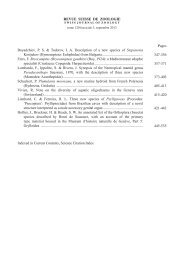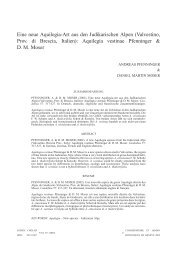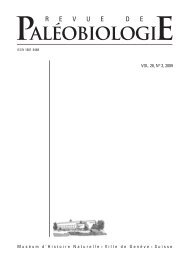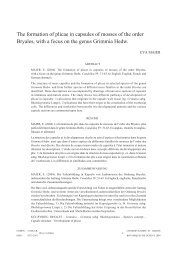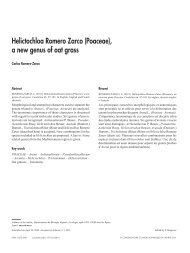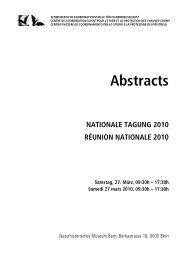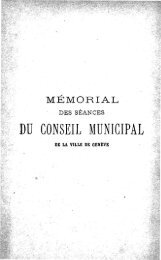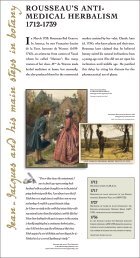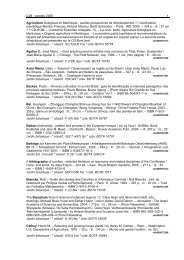Create successful ePaper yourself
Turn your PDF publications into a flip-book with our unique Google optimized e-Paper software.
Begonia callosa L. Kollmann (Begoniaceae), a new species<br />
from the Atlantic forest in the State of Espírito Santo, Brazil<br />
Ludovic Jean Charles Kollmann<br />
Abstract<br />
KOLLMANN, L. J. C. (2007). Begonia callosa L. Kollmann (Begoniaceae),<br />
a new species from the Atlantic forest in the State of Espírito Santo, Brazil.<br />
Candollea 62: 141-144. In English, English and French abstracts.<br />
Begonia callosa L. Kollmann is a new species <strong>de</strong>scribed and<br />
illustrated. It is related to Begonia reniformis Dryand., from<br />
which it differs by the apical calluses on the petioles and<br />
hypopodia, the carinate stipules, and the strongly canaliculate<br />
and zigzag stems.<br />
Key-words<br />
BEGONIACEAE – Begonia – Brazil – State of Espírito Santo<br />
– Atlantic Forest<br />
Résumé<br />
Address of the author: Museu <strong>de</strong> Biologia Prof. Mello Leitão, 4 Av. José Ruschi CEP 29650-000 Santa Teresa, ES, Brazil.<br />
Email: ludovic@limainfo.com.br<br />
Submitted on January 9, 2007. Accepted on August 10, 2007.<br />
ISSN: 0373-2967 Candollea 62(2): 141-144 (2007)<br />
KOLLMANN, L. J. C. (2007). Begonia callosa L. Kollmann (Begoniaceae),<br />
une nouvelle espèce <strong>de</strong> la forêt atlantique <strong>de</strong> l’Etat d’Espirito Santo, Brésil.<br />
Candollea 62: 141-144. En anglais, résumés anglais et français.<br />
Begonia callosa L. Kollmann est une nouvelle espèce décrite et<br />
illustrée. Cette espèce est proche <strong>de</strong> Begonia reniformis Dryand.,<br />
mais s’en différencie par la présence <strong>de</strong> cals à l’extré mité <strong>de</strong>s<br />
pétioles et <strong>de</strong>s hypopo<strong>de</strong>s, ses stipules fortement carenés et <strong>de</strong>s<br />
entrenoeuds caulinaires fortement caniculés et en zigzag.<br />
© CONSERVATOIRE ET JARDIN BOTANIQUES DE GENÈVE 2007
142 – Candollea 62, 2007<br />
Introduction<br />
The family Begoniaceae comprises two genera: Hillebrandia<br />
Oliver, with one species from the Hawaiian Islands,<br />
and Begonia L. (CLEMENT & al., 2004), pantropical and with<br />
about 1400 species (DOORENBOS & al., 1998), of which about<br />
240 are native to Brazil (SMITH & al., 1986), mostly along the<br />
Atlantic Forest (DUARTE, 1961). The Atlantic Forest was<br />
recently classified as one of the 25 most important world<br />
hotspots for conservation (SIMÕES & al., 2002; MITTERMEIER<br />
& al., 1999) because of the threats to its conservation, of its<br />
large biological wealth, and of its high level of en<strong>de</strong>mism. In<br />
the Atlantic Forest, Begonia species occur in different habitats<br />
such as marshes, sunlight place and wet soil, rain and dry forest,<br />
altitu<strong>de</strong> vegetation, and xerophytic vegetation (BRADE,<br />
1961).<br />
During fieldwork in the mountainous region of central<br />
Espírito Santo State, we collected a species of Begonia that<br />
we are proposing as new and <strong>de</strong>scribing herein.<br />
Result and discussion<br />
Begonia callosa L. Kollmann, spec. nova (Fig. 1)<br />
Typus: BRAZIL. Espírito Santo: Fundão, Goiapaba-açu,<br />
21.X.2005, L. Kollmann 8388 & A. P. Fontana (holo-:<br />
MBML; iso-: RB).<br />
Species haec B. reniformi Dryand. affinis, sed petiolis et<br />
hypopodiis apicis callosis, stipulis carinatis, caulibus angulosis<br />
et caniculatis differt.<br />
Suffrutescent herbs 2-3 m tall, pilose, trichomes simple.<br />
Stems 1-2.2(-4.5) cm in diameter, green, brown with age, striate,<br />
lenticels present, interno<strong>de</strong>s 3-10(-35) cm long. Petioles<br />
13-21 cm, green, base and apex reddish, adaxial face sulcate,<br />
apically sulcate and callose, lenticels present. Stipules <strong>de</strong>ciduous,<br />
2-4.5 cm long, green, ovate to triangular, carinate. Leaf<br />
bla<strong>de</strong>s (20-)26-45(-55) (14-)18-27(-42) cm, green, abaxial<br />
face reddish green, pilose, base cordate, apex acuminate; margins<br />
serrate, lightly ciliate; venation actinodromous, veins 6-<br />
7, pilose, stomates single. Inflorescence 26-69 cm long, with<br />
6-9 no<strong>de</strong>s, green, dichasial, the first hypopodium sulcate with<br />
an apical callus, the others lightly sulcate, all with apical calluses,<br />
lenticels present. Bracts persistent, opposite, 2-10 mm<br />
long, triangular, glabrous, apex acute and apiculate. Staminate<br />
flowers: peduncles 5.5-6 mm long, reddish pink; tepals 4,<br />
white, the outer 0.5-1 0.4-0.6 cm, concave, obelliptic, margins<br />
reddish, apex roun<strong>de</strong>d to obtuse, the inner 0.5-0.7 0.15-<br />
0.3 cm, oblong to obovate, apex acute; stamens ca. 27, yellow,<br />
rimose, obovate, filaments unequal, the connective projecting<br />
beyond the anthers. Pistillate flowers: pedicels 5.5-14 mm long,<br />
white; tepals 5, 0.55-1 0.15-0.6 cm, unequal, ovate to obovate,<br />
apex acute; styles 3, yellow, bifurcate, spirally twisted,<br />
united at base, stigma with rows of stigmatic papillae on the<br />
branches, placenta one per locule, ovules present on both surfaces.<br />
Capsules 0.8-1.2 0.4-0.5 cm, glabrous, basally <strong>de</strong>hiscent,<br />
wings 3, the larger 0.8-1.2 1.1-1.6 cm, the smaller two<br />
0.8-1.3 1-2 mm, glabrous. Seeds cylindrical, oblong.<br />
Paratypi. – BRAZIL. Espirito Santo: Fundão municipality,<br />
Alto Piaba, 27.VII.1988, W. Boone 1219 & al. (MBML,<br />
RB); Goiapaba-açu, 18.III.2005, L. Kollmann 7470 & al.<br />
(MBML); Santa Teresa municipality, Valsugana Velha,<br />
24.V.2000, L. Kollmann 2959 & al. (MBML); Rio Saltinho,<br />
7.VI.2001, L. Kollmann 3852 & al. (MBML); 21.X.2005, L.<br />
Kollmann 8373 & al. (MBML); Valsugana Velha, Estação<br />
Biológica <strong>de</strong> Santa Lúcia, 19.VI.2001, L. Kollmann 4095 &<br />
al. (MBML); 11.IX.2005, L. Kollmann 8430 & al. (MBML);<br />
Nova Lombardia, Reserva Biológica Augusto Ruschi,<br />
16.X.2001, L. Kollmann 4871 & al. (MBML); Santa Leopoldina<br />
municipality, Suíça, 29.I.2006, A. P. Fontana 1933 &<br />
A. M. Assis (MBML); Atílio Vivácqua municipality, Moitão,<br />
27.IV.2007, L. Kollmann & al. 9763 (MBML).<br />
Etymology. – The epithet refers to the apical calluses of<br />
petioles and hypopodia.<br />
Begonia callosa grows in sunlight in the leaf litter<br />
and humus of rocky openings of the Atlantic Forest, at 200 to<br />
800 m. It is also found growing in low canopy forests from<br />
open environments on sandy soil.<br />
Begonia callosa resembles B. reniformis Dryand., another<br />
Brazilian species of sect. Pritzelia (Klotzsch) A. DC., due to<br />
its lobate leaves, inflorescences, flowers and fruits. Nevertheless,<br />
it can be distinguished from B. reniformis by the presence<br />
of a callus at the apex of the petioles and hypopodia, petioles<br />
adaxially sulcate, the strongly carinate stipules and the strongly<br />
canaliculate and zigzag stems.<br />
Acknowledgments<br />
We acknowledge the staff of Mello Leitão Biological<br />
Museum, especially Helio <strong>de</strong> Queiroz Bou<strong>de</strong>t Fernan<strong>de</strong>s,<br />
Director of the Museum and Curator of MBML, for their<br />
collaboration. Marcos Sobral for suggestions and help with<br />
the English version and Latin diagnosis. The Petrobras to<br />
financing the project.<br />
References<br />
BRADE, A. C. (1961). O porte das begônias brasileiras e os ambientes<br />
on<strong>de</strong> ocorrem. Arch. Jard. Bot. Rio <strong>de</strong> Janeiro 17: 51-55.<br />
CLEMENT, W. L., M. C. TEBBITT, L. L. FORREST, J. E. BLAIR,<br />
L. BROUILLET, T. ERIKSSON & S. M. SWENSEN (2004). Phylogenetic<br />
position and biogeography of Hillebrandia sandwicensis<br />
(Begoniaceae): a rare Hawaiian relict. Amer. J. Bot. 91: 905-917.
Begonia callosa L. Kollmann (Begoniaceae), a new species from the Atlantic forest in the State of Espírito Santo, Brazil – 143<br />
DOORENBOS, J., S. M. SOSEF & J. J. F. E. DE WILDE (1998). The<br />
sections of Begonia. Studies in Begoniaceae VI. Wageningen<br />
Agric. Univ. Pap. 98(2): 1-266.<br />
DUARTE, A. P. (1961). Consi<strong>de</strong>rações acerca do comportamento e<br />
dispersão <strong>de</strong> algumas espécies <strong>de</strong> Begônias do Estado da Guanabara.<br />
Arch. Jard. Bot. Rio <strong>de</strong> Janeiro 17: 57-105.<br />
MITTERMEIER, R. A., N. MYERS & C. G. MITTERMEIER (1999). Hotspots<br />
Earth s biologically richest and most endangered terrestrial ecoregions.<br />
Conservation Internacional.<br />
SIMÕES, L. L. & C. F. LINO (2002). Sustentável Mata Atlântica: a<br />
exploração <strong>de</strong> seus recursos florestais. Editora Senac.<br />
SMITH, L. B., D. C. WASSHAUSEN, J. GOLDING & C. E. KAREGEANNES<br />
(1986). Begoniaceae. Part I: Illustrated key. Part II: Annoted<br />
Species List. Smithsonian Contr. Bot. 60: 1-584.<br />
Fig. 1. – Begonia callosa L. Kollmann. A. Habit; B. Petiole callus apice; C. Cross section of peciole callus; D. Cross section of petiole base; E. Stipule, lateral view;<br />
F. Stipule, abaxial face exten<strong>de</strong>d; G. Petal male flower; H. Sepal male flower; I. Stamen; J. Tepal femal flower; K. Stigma, adaxial face; L. Stigma, abaxial face;<br />
M. Fruit; N. Seed.<br />
[Drawn by the author]




